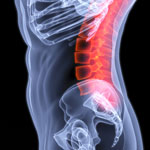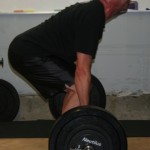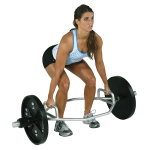I think it is safe to say most would agree that deadlifts are great for building maximal lower body strength. Elite Olympic weightlifters are generally able to lift more loads in this lift compared to other free weight exercises. I know personally that I like to use it to develop lumbar extensor strength, as well as in place of the squat if I want to avoid spinal compression from the weight of the bar.
In the past I have heard some strength coaches say they don’t use a hex bar for deadlifts because it is not the same as lifting a straight bar. While not always sure exactly what they mean by that, I found a recent article in the July 2011 Journal of Strength & Conditioning Research very insightful. The researchers looked at the difference between straight and hexagonal bar deadlifts in submax loading situations.
The concern with deadlifting has always been stress on the spine. The study notes:
“For world class athletes lifting extremely heavy loads, lumbar disk compression forces as large as 36,400 N have been reported.”
Lifters have long been encouraged to keep the barbell as close to them as possible to reduce the moment arm. The issue with the straight bar is that it can impinge on the body. Thus, the trap bar or hex bar apparatus was developed. The researchers hypothesized that the hex bar would reduce the joint movements and resistance moment arms. In addition, they hypothesized that larger forces would be produced with the submax loads.
The study use 19 male powerlifters and was conducted 3 months after their most recent competition where most were at the end of a training cycle aimed at matching or exceeding their previous competition performance. The subjects (following their own warm-up) performed HBD and SBD at 10, 20, 30, 40, 50, 60, 70 and 80% of his SBD 1RM. Twelve markers were placed on the body for biomechanical analysis.
So what did the researchers discover? In a nutshell, here are the main findings of the report:
- HBD significantly increased the peak moment at the knee and significantly decreased the peak moment at the lumbar spine and hip compared to the the SBD
- For loads greater than 60% 1RM, the hex bar increased displacement toward the body 22% thereby reducing the moment arm across all joints throughout the loads
- The larger peak moment at the knee with the HBD is explained by the load – in the HBD it is behind the knee creating a flexion moment for most of the movement, whereas with the SBD it is in front of the knee creating an extension moment
- If the goal is to maximize erector spinae muscles, then use the SBD, however with individuals with a history of low back pain or finishing rehab, the HBD is a good alternative
- The deadlift can be combined with submaximal loads to generate large power outputs
- It may be worthwhile including the deadlift in structured periodization models aimed at developing muscular power
- The HBD can produce significantly greater peak force, peak velocity, and peak power values than the SBD
What is my take on all this? Well, I have always loved to squat. That all changed with a recurring L5/S1 disc issue. As such, I now use dumbbells and the HBD from time to time. I think we must consider the following when making exercise selection decisions:
- Risk should never outweigh reward so in those clients with previous disc pathology and for those NOT competing I would prefer the HBD to reduce load on the lumbar spine
- The HBD increases the moment at the knee and reduces it at the hip – this is noteworthy perhaps if developing the max hip power is the aim based on the location of the resistance throughout the motion
- Joint mobility and flexibility may dictate your exercise selection so be astute in assessing hip and ankle mobility (recommend looking at ASLR and deep squat mechanics)
- Submax loads are effective for developing large forces which is worth noting. Some, however, have argued that too much time is spent decelerating load near the end of the movement, yet I believe the authors point out this has been restricted to bench press. At 80% 1RM, about 87% of the time with the HBD is spent accelerating the resistance compared to 80.6% in the SBD. So, I think we need more definitive research looking at lifts other then the bench press to tell us how much of a detriment (if any) the lighter loads with respect to performance goals.
In the end, I like both methods of training, but would have to give the nod to the HBD for the majority of athletes I work with as I feel the risk of injury is less and the strength and power gains are solid in comparison to the SBD. Integrating routine ankle and hip mobility as part of a dynamic warm-up is recommended for those performing SBD, and I would suggest corrective exercises would be suggested for those with mobility restrictions prior to moving to the SBD.




